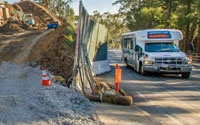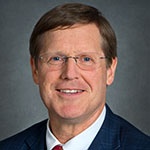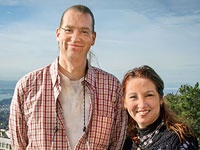A lot is happening and it’s a given we all have to be aware while driving and walking here on the hill. So what can we do as a community to make our roads and walkways safer? Drivers of construction vehicles have been given strict instructions to use their lowest gears and to not text or talk on cell phones while driving on the hill. Most of these subcontractor drivers are complying, though I hear occasional accounts of some drivers – including both automobile and construction vehicle drivers – not heeding stop signs or driving through pedestrian-occupied crosswalks. And often I see improperly parked vehicles obstructing marked roadways and walkways.
I’d like to enlist your help to address these issues. It will require both innovation and teamwork, where we are all watching out for each other. I encourage you to post your ideas and comments on this subject to our Safety Culture Forum. Let’s keep the conversation going on how we can all help each other make Berkeley Lab’s thoroughfares safer. The Forum is also a great platform to voice other Safety Culture related topics, ideas, and concerns.
Thanks for your help!
— Glenn Kubiak
With two prolapsed disks, the 6’ 4” German-born scientist has become as sharply focused on ergonomic safety inside the laboratory as he is on exploring the dynamics of atoms and molecules inside vacuum chambers.
With help from EHSS ergonomist Melanie Alexandre, he has created a new partnership to prevent ergonomics-related injuries among scientists and staffers working with the unique equipment found throughout Berkeley Lab.
“Every day, I bring my bad back to the lab,” says Weber. “We want to work safely, and to take this seriously.”
In the office environment, a healthy new respect for ergonomics has led to redesigned keyboards, adjustable chairs and desks, computer glasses, and appropriate training to prevent repetitive stress injuries at workstations. Weber says the same attention to detail is needed to prevent injuries when working around laboratory equipment. “Ergonomics should not stop at the office,’’ he says.
Scientific labs are unusual environments, often filled with big, heavy, one-of-a-kind contraptions built with stainless steel pipes and chambers. Daily work around them can involve awkward body stretches to tighten a fitting; extended reaches to raise heavy objects; and pretzel-like contortions to make adjustments to out-of-the way switches, bolts, and gauges. People can and do get hurt, and Weber is adamant: “these injuries are preventable.”
Weber says he struggled for a long time to develop a systematic approach to ergonomic issues in the laboratory, but his efforts did not bear fruit until he got help from Richard DeBusk at EHSS, who listened to his concerns and assigned Alexandre to work with him. “I put my ‘laundry list’ on the table, and she helped me organize and realize suitable remedies,” says Weber. They took a project-management approach, identifying problems and solutions and then tracking their progress in meeting goals. Alexandre lined up experts and vendors. Sometimes the answer lay in buying ergonomically designed wrenches and power tools. Sometimes it was simply to purchase new step-ladders and stools. Sometimes the scientists had to build their own platforms from ubiquitous 80/20 aluminum frames. For jobs requiring a stretch forward to access hard-to-reach places, Weber’s Chemical Sciences Division colleagues designed and built a “leaning frame” to support a worker’s torso.
“Scientists themselves have so many different priorities that they can’t do this alone,” says Alexandre, a Certified Professional Ergonomist working for EHSS. “They are busy. They have deadlines.” She sees her role as that of a facilitator, coordinator, and communicator. She tries to draw on experts from across divisions and outside the lab, building an interlocking network of expertise. “We’re not just helping people who are in discomfort,’’ Alexandre explains. “We are about understanding the human side of our interaction with equipment and machines.”
Safety involving ladders, lasers, and hazardous materials has always been paramount at Berkeley Lab, and she works closely with division safety coordinators to make sure that “our brilliant new idea for ergonomic improvement doesn’t create a new and unexpected hazard.” It involves lots of meetings, she says, “with all the right people in the same room.”
In six short months of working with Alexandre, Weber said enormous progress has been made in addressing concerns that have worried him for years. So far in this collaborative effort, his group has spent $4,000 on safety equipment. “Melanie has helped us spend our scarce time and money wisely,’’ he says.
Every time he is reminded by a jolt of back pain, Weber is haunted by the notion that it could happen to someone else. Investments in a culture of safety, he says, are a bargain. “If only I hadn’t lifted that lid… It only has to happen once, and it can change your whole life.”



